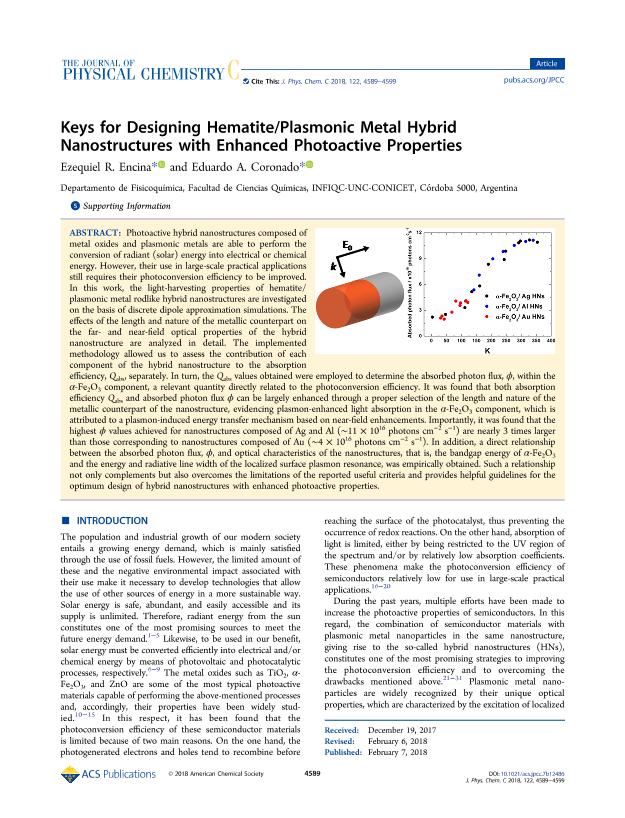Mostrar el registro sencillo del ítem
dc.contributor.author
Encina, Ezequiel Roberto

dc.contributor.author
Coronado, Eduardo A.

dc.date.available
2021-07-05T20:44:08Z
dc.date.issued
2018-03
dc.identifier.citation
Encina, Ezequiel Roberto; Coronado, Eduardo A.; Keys for designing hematite/plasmonic metal hybrid nanostructures with enhanced photoactive properties; American Chemical Society; Journal of Physical Chemistry C; 122; 8; 3-2018; 4589-4599
dc.identifier.issn
1932-7447
dc.identifier.uri
http://hdl.handle.net/11336/135491
dc.description.abstract
Photoactive hybrid nanostructures composed of metal oxides and plasmonic metals are able to perform the conversion of radiant (solar) energy into electrical or chemical energy. However, their use in large-scale practical applications still requires their photoconversion efficiency to be improved. In this work, the light-harvesting properties of hematite/plasmonic metal rodlike hybrid nanostructures are investigated on the basis of discrete dipole approximation simulations. The effects of the length and nature of the metallic counterpart on the far- and near-field optical properties of the hybrid nanostructure are analyzed in detail. The implemented methodology allowed us to assess the contribution of each component of the hybrid nanostructure to the absorption efficiency, Qabs, separately. In turn, the Qabs values obtained were employed to determine the absorbed photon flux, ø, within the α-Fe2O3 component, a relevant quantity directly related to the photoconversion efficiency. It was found that both absorption efficiency Qabs and absorbed photon flux ø can be largely enhanced through a proper selection of the length and nature of the metallic counterpart of the nanostructure, evidencing plasmon-enhanced light absorption in the α-Fe2O3 component, which is attributed to a plasmon-induced energy transfer mechanism based on near-field enhancements. Importantly, it was found that the highest ø values achieved for nanostructures composed of Ag and Al (∼11 × 1016 photons cm-2 s-1) are nearly 3 times larger than those corresponding to nanostructures composed of Au (∼4 × 1016 photons cm-2 s-1). In addition, a direct relationship between the absorbed photon flux, ø, and optical characteristics of the nanostructures, that is, the bandgap energy of α-Fe2O3 and the energy and radiative line width of the localized surface plasmon resonance, was empirically obtained. Such a relationship not only complements but also overcomes the limitations of the reported useful criteria and provides helpful guidelines for the optimum design of hybrid nanostructures with enhanced photoactive properties.
dc.format
application/pdf
dc.language.iso
eng
dc.publisher
American Chemical Society

dc.rights
info:eu-repo/semantics/openAccess
dc.rights.uri
https://creativecommons.org/licenses/by-nc-sa/2.5/ar/
dc.subject
Hybrid nanostructures
dc.subject
Optical properties
dc.subject
Near field
dc.subject
Absorption enhancement
dc.subject.classification
Físico-Química, Ciencia de los Polímeros, Electroquímica

dc.subject.classification
Ciencias Químicas

dc.subject.classification
CIENCIAS NATURALES Y EXACTAS

dc.title
Keys for designing hematite/plasmonic metal hybrid nanostructures with enhanced photoactive properties
dc.type
info:eu-repo/semantics/article
dc.type
info:ar-repo/semantics/artículo
dc.type
info:eu-repo/semantics/publishedVersion
dc.date.updated
2021-07-05T14:35:34Z
dc.identifier.eissn
1932-7455
dc.journal.volume
122
dc.journal.number
8
dc.journal.pagination
4589-4599
dc.journal.pais
Estados Unidos

dc.journal.ciudad
Washington
dc.description.fil
Fil: Encina, Ezequiel Roberto. Consejo Nacional de Investigaciones Científicas y Técnicas. Centro Científico Tecnológico Conicet - Córdoba. Instituto de Investigaciones en Físico-química de Córdoba. Universidad Nacional de Córdoba. Facultad de Ciencias Químicas. Instituto de Investigaciones en Físico-química de Córdoba; Argentina
dc.description.fil
Fil: Coronado, Eduardo A.. Consejo Nacional de Investigaciones Científicas y Técnicas. Centro Científico Tecnológico Conicet - Córdoba. Instituto de Investigaciones en Físico-química de Córdoba. Universidad Nacional de Córdoba. Facultad de Ciencias Químicas. Instituto de Investigaciones en Físico-química de Córdoba; Argentina
dc.journal.title
Journal of Physical Chemistry C

dc.relation.alternativeid
info:eu-repo/semantics/altIdentifier/url/https://pubs.acs.org/doi/10.1021/acs.jpcc.7b12486
dc.relation.alternativeid
info:eu-repo/semantics/altIdentifier/doi/http://dx.doi.org/10.1021/acs.jpcc.7b12486
Archivos asociados
